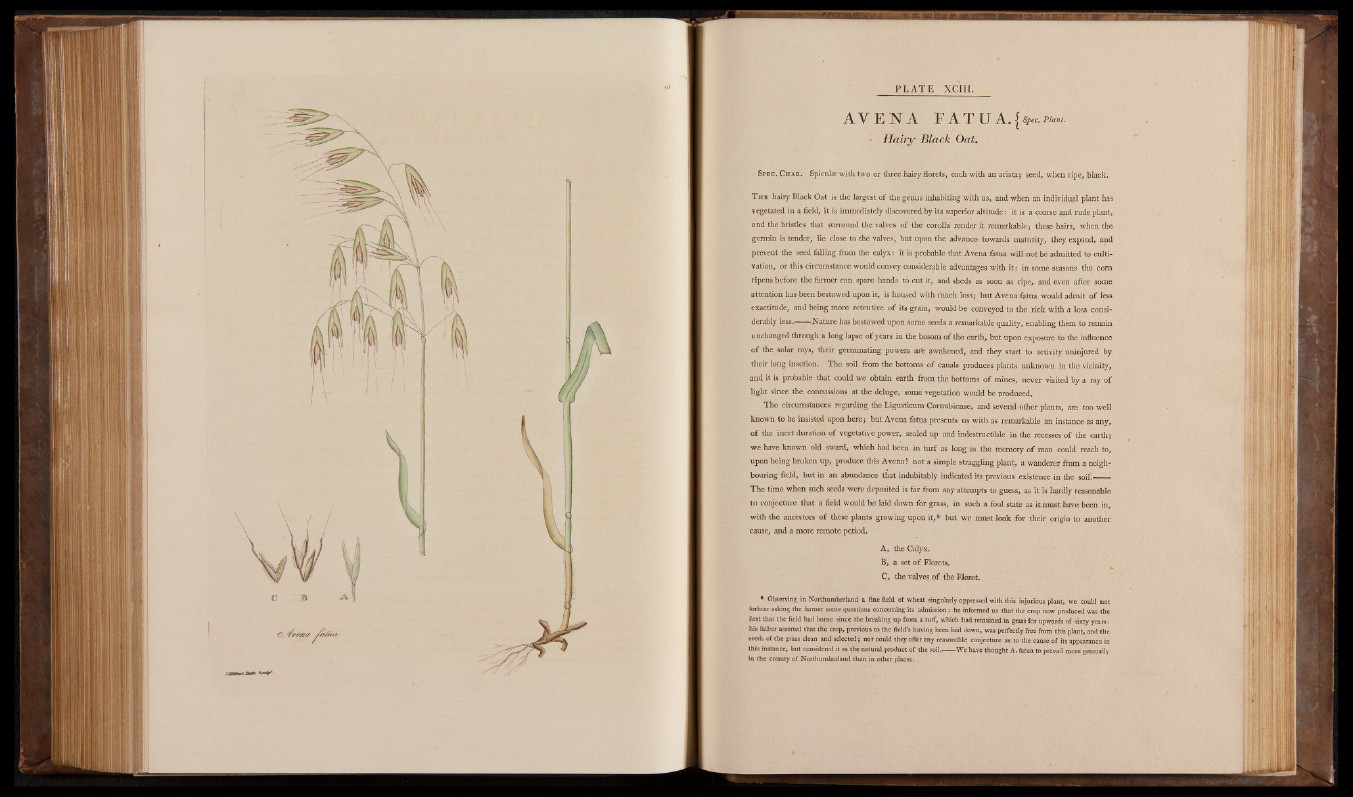
AVENA F AT U A. { plmt-
• Hairy Black Oat.
Spec. Chab. Spiculae with two or three hairy florets, each with an arista* seed, when ripe, black.
T hb hairy Black Oat is the largest of the genus inhabiting with us, and when an individual plant has
vegetated in a field, it is immediately discovered by its superior altitude: it is a coarse and rude plant,
and the bristles that surround the valves of the corolla render it remarkable; these hairs, when the
germin is tender,' lie close to the valves, but upon the advance towards maturity, they expand, and
prevent the seed falling from the calyx: it is probable that Avena fatua will not be admitted to cultivation,
or this circumstance would convey considerable advantages with it: in some seasons the corn
ripens before the farmer can spare hands to cut it, and sheds as soon as ripe, and even after some
attention has been bestowed upon it, is housed with much loss; but Avena fatua would admit o f less
exactitude, and being more retentive o f its grain, would be conveyed to the rick with a loss considerably
less.——Nature has bestowed upon some seeds a remarkable quality, enabling them to remain
unchanged through a long lapse of years in the bosom o f the earth, but upon exposure to the influence
of the solar rays, their germinating powers arfe awakened, and they start to activity uninjured by
their long inaction. The soil from the bottoms o f canals produces plants unknown in the vicinity,
and it is probable that could we obtain earth from the bottoms o f mines, never visited by a ray of
light since the concussions at the deluge, some vegetation would be produced.
The circumstances regarding the Ligusticum Comubiense, and several other plants, are too well
known to be insisted upon here; but Avena fatua presents us with as remarkable an instance as any,
o f the inert duration o f vegetative power, sealed up and indestructible in the recesses of the earth;
we have known old sward, which had been in turf as long as the memory o f man could reach to,
upon being broken up, produce this Avena! not a simple straggling plant, a wanderer from a neighbouring
field, but in an abundance that indubitably indicated its previous existence in the soif. •
The time when such seeds were deposited is far from any attempts to guess, as it is hardly reasonable
to conjecture that a field would be' laid down for grass, in such a foul state as it must have been in,
with the ancestors o f these plants growing upon it,* but we must look for their origin to another
cause, and a more remote period.
A, the Calyx.
B, a set o f Florets.
C, the valves of. the Floret.
• Observing, in Northumberland a fine field of wheat singularly oppressed with this injurious plant, we could not
forbear asking the farmer some questions concerning its admission: he informed us that the crop now produced was the
first that the field had borne since the breaking up from a turf, which had remained in grass for upwards of sixty years:
his father asserted that the crop, previous to the field’s having been laid down, was perfectly free from this plant, and the
seeds of the grass clean and selected; nor could they offer any reasonable conjecture as to the cause of its appearance in
this instance, but considered it as the natural product of the soil.------We have thought A. fatua to prevail more generally
in the county of Northumberland than in other places.